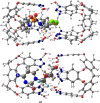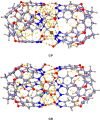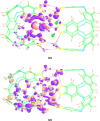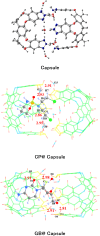Molecular insight into the role of benzotriazole nanocapsule to deliver anticancer drug in smart drug delivery system
- PMID: 40221489
- PMCID: PMC11993643
- DOI: 10.1038/s41598-025-91719-0
Molecular insight into the role of benzotriazole nanocapsule to deliver anticancer drug in smart drug delivery system
Abstract
The use of nanomaterials as drug delivery systems is an area of interest for various anticancer drugs, aiming to minimize their side effects while ensuring they reach the target site effectively. In the current study, Benzotriazole capsule as drug delivery system for cyclophosphamide (CP) and gemcitabine (GB) drugs adsorption is explored. Various electronic and structural parameters shows that both drugs have good interaction with nanocapsule and can be carried to the target site easily. The calculated binding energies of drug@Capsule complexes are in the range of -43.34 and - 56.64 kcal/mol, which shows stronger interaction of drug molecules with nanocapsule. The noncovalent interactions between CP, GB and capsule are confirmed through QTAIM and NCI analyses. NBO analysis is used to understand the shifting of electron density, which shifts from drug to surface. FMO analysis is performed to estimate the perturbations in the electronic parameters upon complexation, which reveals reduction in the EH-L gap. Moreover, pH effect and dipole moment analysis are performed to get insight into the drug release mechanism. Dipole moment values indicate that nanocapsule can effectively release CP drug on a target site. The findings suggest that benzotriazole capsule surface is highly selective toward CP and GB.
Keywords: Anticancer agents; Benzotriazole capsule; Density-functional theory; Drug delivery; Gemcitabine; Sensing.
© 2025. The Author(s).
Conflict of interest statement
Declarations. Competing interests: The authors declare no competing interests.
Figures










Similar articles
-
DFT investigation of therapeutic potential of benzimidazolone capsule as a drug delivery vehicle for anticancer drug.Sci Rep. 2025 Aug 4;15(1):28383. doi: 10.1038/s41598-025-12817-7. Sci Rep. 2025. PMID: 40759698 Free PMC article.
-
Harnessing the Efficiency of Twin Boron Nitride and Graphene Monolayers for Anticancer Drug Delivery: Insights from DFT.ACS Appl Bio Mater. 2025 Mar 17;8(3):2015-2026. doi: 10.1021/acsabm.4c01507. Epub 2025 Feb 7. ACS Appl Bio Mater. 2025. PMID: 39919307 Free PMC article.
-
Efficient Click Synthesis of a Protonized and Reduction-Sensitive Amphiphilic Small-Molecule Prodrug Containing Camptothecin and Gemcitabine for a Drug Self-Delivery System.Mol Pharm. 2019 Sep 3;16(9):3770-3779. doi: 10.1021/acs.molpharmaceut.9b00349. Epub 2019 Aug 8. Mol Pharm. 2019. PMID: 31348660
-
Lessons Learned from Gemcitabine: Impact of Therapeutic Carrier Systems and Gemcitabine's Drug Conjugates on Cancer Therapy.Crit Rev Ther Drug Carrier Syst. 2017;34(1):63-96. doi: 10.1615/CritRevTherDrugCarrierSyst.2017017912. Crit Rev Ther Drug Carrier Syst. 2017. PMID: 28322141 Review.
-
Lipid Nanocapsule: A Novel Approach to Drug Delivery System Formulation Development.Curr Pharm Biotechnol. 2024;25(3):268-284. doi: 10.2174/1389201024666230523114350. Curr Pharm Biotechnol. 2024. PMID: 37231750 Review.
References
-
- Bray, F. et al. Global cancer statistics 2018: GLOBOCAN estimates of incidence and mortality worldwide for 36 cancers in 185 countries. Cancer J. Clin.68 (6), 394–424 (2018). - PubMed
-
- O’Brien, N. A. et al. Tucatinib has selective activity in HER2-positive cancers and significant combined activity with approved and novel breast cancer–targeted therapies. Mol. Cancer Ther.21 (5), 751–761 (2022). - PubMed
-
- Cheng, W. J. et al. Bispecific T-cell engagers non-covalently decorated drug-loaded pegylated nanocarriers for cancer immunochemotherapy. J. Control. Release. 344, 235–248 (2022). - PubMed
-
- Corti, A. et al. Targeted drug delivery and penetration into solid tumors. Med. Res. Rev.32 (5), 1078–1091 (2012). - PubMed
-
- Bahrami, B. et al. Nanoparticles and targeted drug delivery in cancer therapy. Immunol. Lett.190, 64–83 (2017). - PubMed
MeSH terms
Substances
Grants and funding
LinkOut - more resources
Full Text Sources
Miscellaneous

